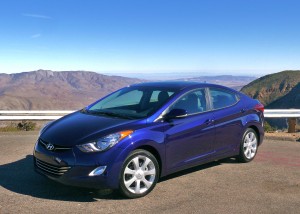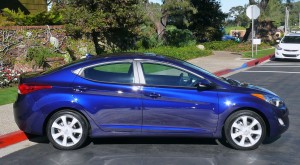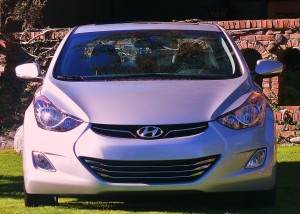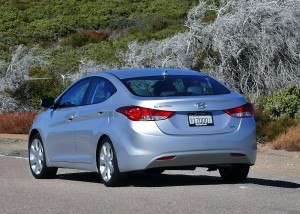Hyundai elevates Elantra to head of compact class
By John Gilbert
The 2010 Hyundai Elantra is a nice, competitive sedan, worthy of consideration against the Toyota Corolla, Nissan Sentra, or even the Honda Civic or Mazda3 among stalwarts of the compact class because of its inexpensive price sticker and impressive warranty. However, as seems to be the case in recent Hyundai philosophy, why stay with competitive when superlatives can be attained? For 2011, the totally renovated Elantra is, in a word, superlative.
The transformation is similar to what Hyundai achieved with the midsize Sonata a year ago. The previous Sonata was a good midsize car, competitive if unexciting and uninspiring — but Hyundai brought all its current technology together and created its own pedestal in the auto industry with the 2011 Sonata, which combines style, substance, price, technology, and performance all into one outstanding vehicle.
Move down a step, from midsize to compact, and the new Elantra for 2012 greatly resembles a downsized Sonata, with dramatic and curvaceous styling, surprising interior room, 40-miles-per-gallon efficiency from its strong new engine/transmission combination, and all at a price that could make it the new standard of a suddenly revitalized segment. With the Ford Focus, Chevrolet Cruze and Honda Civic rising up to meet the demands of consumers who want fuel-efficiency in the face of over-$3 gas prices, jumping into the thick of that battle is no small task. But the Elantra clears that hurdle with graceful ease.
The Cruze and the Focus, as well as the smaller Ford Fiesta, all have come out with impressive entries for 2011, and all have a specialty model, slimmed down and streamlined, and aiming to reach 40 miles per gallon. Hyundai president John Krafchik scoffs at that, saying why don’t rivals build their base or mainstream models to achieve the highest fuel economy? Why should customers have to pay more for better fuel-efficiency? With that, Hyundai rolls out the Elantra, which will be built alongside the Sonata in Hyundai’s plant at Montgomery, Ala., with the projection that all Elantra models will top 40 mpg.
Designer Cedric D’Andre said his California design team collaborated with the Namyong studio, and with engineers to get all the proportions just right. And the appearance, from every angle, makes the Elantra look like something more than a traditional compact. The ingredients beneath the sheetmetal are impressive, but the success of the Elantra will mostly hinge on the two-pronged first-impression features of its striking good looks and its surprisingly low price.
The GLS model starts at a basic price of $14,830 for the 6-speed manual. Adding options and the automatic boost the sticker to $17,080, and fully loaded, with a navigation system and 7-inch screen, the GLS can rise to $19,980. The Limited model adds more interior content and starts at $19,980, while the full-boat Limited with the premium package tops out at $21,980. The base car has impressive equipment, and adding options pushes it to a luxury level that used to be beyond the grasp of compact buyers.
Scott Margason, director of product planning for the Elantra, described how the intention was to move Elantra away from its conventional/traditional status up into the modern/sporty area, currently populated by only the Mazda3 and the Si model of the Civic. Dynamic styling is one of the keys to the new Elantra, Margason explained, with sculptured contours that start at the grille, continue on the hood, and on both sides — not unlike the Sonata — and the sweeping silhouette stretches over a 1-inch longer car with a 2-inch longer wheelbase.
With 95.6 cubic feet of total interior room, the Elantra fits into the larger midsize spaciousness, and Hyundai claims it has more interior room than the Nissan Maxima. Hyundai also has worked its magic to bring the Elantra in at a mere 2,661 pounts, which makes it 62 pounds lighter than its predecessor, and lighter than the Corolla, Sentra or the over-3,000-pound Cruze. The Civic (2,630) and Focus (2,623) are slightly lighter than the Elantra, but there’s more to the story.
Being lighter is not automatically a good thing, from a safety standpoint, but the Elantra meets both ends of the compromise. Hyundai is the only automaker that owns its own steel plant, and has 400 engineers and metallurgy experts developing high-grade steel that is both lighter and stronger than the less-expensive normal steel. The new Elantra boasts a 37-percent improvement in body stiffness, and its strength is underscored by the highest safety ratings.
Along with a stylish, safe, and spacious body, the Elantra uses a newly refined 1.8-liter “Nu” 4-cylinder engine, which develops 148 horsepower and 131 foot-pounds of torque, and has mileage estimates of 29 city, and 40 highway. The larger Sonata also has good fuel-economy numbers, and frequently exceeds them in real-world driving. After hearing from consumers who bought Sonatas with stories of 40-42 miles per gallon, I recently spent a week with a Limited model and made a 150-mile freeway trip that attained 41.5 mpg. So the smaller Elantra should be able to top 40.
The 1.8 is from a different engine family, but it has the advantage of the recently escalating Hyundai engineers’ expertise. The Theta engine, which powers the Sonata and the Tucson SUV has 2.4-liter displacement, and can be downsized to the 2.0-liter size that is used with the turbocharged high-performance Sonata. Engineers said making it still smaller was not advisable, so the Nu engine came out after considerable research and development time. The new all-aluminum Nu is 74 pounds lighter than the cast-iron engine previously used in the Elantra. It has variable valve-timing onboth the intake and exhaust sides of its dual overhead-camshafts, which, impressively, are operated by a timing chain, rather than the less-costly belt, eliminating the usual concern on many overhead-cam engines about changing timing belts to avoid serious engine damage.
One of the things that makes the Sonata’s 2.4-liter engine so efficient is a high-pressure direct-injection system, plus Hyundai’s own 6-speed automatic transmission. The 1.8 doesn’t have direct injection, leaving something for a future upgrade, if Hyundai finds that competitors are catching up. It does, however, use its new and compact 6-speed automatic transmission, as well as a 6-speed manual, and both transmissions make the smaller engine feel more than adequate. On tight and twisting mountain roadways, it felt somewhere between sporty and high-performance in agility level.
Hyundai engineers have computed fuel savings from various factors with the Nu 1.8 engine gaining 7.4 percent improvement, the transmission (4.1 percent better), a revised alternator (2.5 percent), low rolling-resistance tires (1.4 percent), weight savings (1.8 percent), and lowered coefficient of drag (0.5 percent), to come up with a total fuel saving of 17.7 percent over the 2010 Elantra.
We drove the Elantra from San Diego’s favorite media-introduction location, which is the Lodge at Torrey Pines — right near Hyundai’s high-tech corporate offices in the U.S., and adjacent to the golf course that held the PGA tournament in late-January, and we drove through some spectacular mountain-top roadways that wound up to 6,000 feet elevation and back down and around canyons, for a thorough performance and handling route.
I enjoyed driving it hard around the tightest mountain road switchbacks, and the Elantra was always stable, with the seating comfort and support as good as the suspension. Over the last decade, the Civic Si set the standard for handling in the compact segment, and the MazdaSpeed3 challenged it. Those two cars also have the edge over competitors in normal-model handling, and it appears initially that the new Elantra will definitely be in that segment-leading class.
Among Elantra’s standard features for all models are cruise control, rear defroster, air conditioning, 4-wheel disc brakes (with shorter 60-0 stopping distances than Civic, Corolla or Mazda3). Elantra and Mazda3 are the only two that have standard 4-wheel discs in the segment. Elantra adds traction control and electronic stability control as standard, plus VSM, a Vehicle Stability Management system that integrates both, plus antilock brakes and electronic brake-force distribution with brake assist, electronic power steering, and six airbags. The stability control can be turned off to allow freer spinning when encountering a deep-snow or sand situation.
Brandon Ramirez, manager of product planning for Elantra, said that the Elantra’s 7-inch touchscreen which displays video from the back-up camera, is the largest in the compact segment, and available on both the upgraded GLS and Limited models. Other features that are available are leather seats, heated front seats as well as rear seats, push-button start, a 360-watt audio with an external amplifier, Bluetooth hands-free telephone system, and power sun-roof, among others.
The instruments are efficient and sporty, and other interior touches are particularly noteworthy. Instead of a plastic material commonly used, either hard or softened, the cloth-looking lining on the inside of the pillars is made of a unique material combining fibrous tissue and volcanic rock. Nice touch.
As usual, Hyundai offers its 10-year, 100,000-mile warranty. Hyundai also claims more standard features than the Civic, Corolla, Mazda3, Sentra, Cruze or Focus, while offering more standard attributes, for a price that is less than any of them. With all that going for it, the new Elantra may prove to be a repeat performer to the Sonata, only in the compact segment.
Comments
Tell me what you're thinking...
and oh, if you want a pic to show with your comment, go get a gravatar!






 John Gilbert is a lifetime Minnesotan and career journalist, specializing in cars and sports during and since spending 30 years at the Minneapolis Tribune, now the Star Tribune. More recently, he has continued translating the high-tech world of autos and sharing his passionate insights as a freelance writer/photographer/broadcaster. A member of the prestigious North American Car and Truck of the Year jury since 1993. John can be heard Monday-Friday from 9-11am on 610 KDAL(www.kdal610.com) on the "John Gilbert Show," and writes a column in the Duluth Reader.
John Gilbert is a lifetime Minnesotan and career journalist, specializing in cars and sports during and since spending 30 years at the Minneapolis Tribune, now the Star Tribune. More recently, he has continued translating the high-tech world of autos and sharing his passionate insights as a freelance writer/photographer/broadcaster. A member of the prestigious North American Car and Truck of the Year jury since 1993. John can be heard Monday-Friday from 9-11am on 610 KDAL(www.kdal610.com) on the "John Gilbert Show," and writes a column in the Duluth Reader.